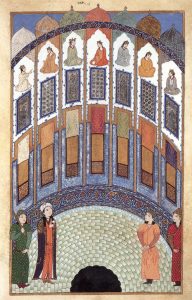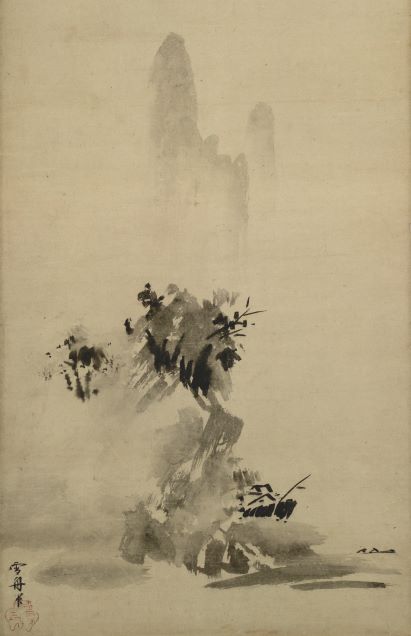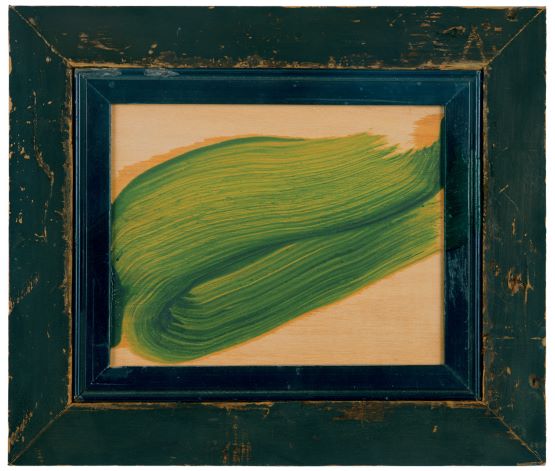The World According to Colour. A Cultural History by James Fox
Imagine my delight upon reading the opening to World According to Colour, only to discover the Haft Paykar, a famous medieval romantic poem – considered one of the great classics of Persian literature;
‘One day, a young Persian prince was wandering through his palace when something stopped him in his tracks. His eyes soon settled on a series of paintings, depicting seven beautiful princesses from seven different realms.’ – World According to Colour

In the Haft Paykar (Seven Portraits), the young prince Bahram Gur, seeks out seven princesses from seven climes ruled by seven planets (classical planetary system of Zoroastrian-Islamic world); India, Byzantium, Russia, Slavonia, North Africa, China and Persia. Upon marrying all seven and bringing them back to Persia, his architect advises him that to assure good fortune, each princess should be housed in a pavilion with a coloured dome associated with her respective clime, planet and weekday. Bahram Gur makes daily visits to the princesses – and at each stage embarks further on a journey of self-enlightenment.
World According to Colour. A Cultural History by James Fox
As in the poem, James Fox in his new book, World According to Colour, invites the reader on a journey, only this time, through humanity’s cultural relationship with colour. The colours become protagonists, like complex characters in a seven-part play. The author’s aim is that the reader understands the meanings associated with colour to civilisations over time.
Unlike the colours that feature in the Haft Paykar, his book goes back into time to ancient Greece and follows the modern equivalents of Aristotle’s seven primaries: black, red, yellow, blue, white, purple and green in seven chapters devoted to these colours.
Dr James Fox is an art historian and therefore may have developed a predilection for color through his exposure to visual art – some may call it an occupational hazard. Nevertheless, the reader gains valuable insight into his 10 years of research and lifelong passion for colour.
Different Shades of Black
In the chapter on black, we learn that ‘black’ was the most frequently used term in Shakespeare’s writings and that he seemed to harbor a certain fondness of adjectives like ‘black as ink’. ‘coal-black, ‘raven black’. Perhaps we can presume that black was the Bard’s favourite colour.
Shifting East, he sheds light on the East Asian perspective to the colour black, as he discusses the revered Japanese novelist Tanizaki’s 1933 essay, In Praise of Shadows – in which Tanizaki argued that darkness was integral to eastern aesthetics as opposed to the Western obsession with bright light and sparkling, shiny surfaces. Dr Fox further illuminates the reader on the significance of black in Chinese and Japanese ink painting;
‘At first the Chinese used this rich black fluid for writing, calligraphy and painting, but by the T’ang dynasty they were also using it to paint. Chinese painters began by pairing it with other colours but many later renounced everything except black. Not that they considered it to be a single colour; they recognised at least five different blacks.’

We learn about Sesshū Tōyō (雪舟 等楊), a 15th century Japanese master of ink and wash painting, who drew influences from the Chinese landscape painting and adapted these to his own practice. In his painting, ‘splashed ink landscape’,(溌墨) hatsuboku, the artist avoids bold outlines and expresses himself with ink washes in lighter and darker tones.
Red, Yellow, Blue, White and the Colour Purple
We learn about the dominance of red in China from time immemorial to the red flag of the Chinese Communist Party and discover that Turner was particularly partial to chrome yellow, a pigment developed in his lifetime after its main ingredient was discovered in a Siberian gold mine. It went on to become the most successful pigment and was used in Gaughin’s Yellow Christ and Van Gogh’s Sunflowers.
In the chapter on blue we learn of Yves Klein’s obsession with the sky and of his creation of a deep ultramarine, IKB (International Klein Blue), whilst in the chapter on white, the author bravely and sensitively tackles the subject of ‘race’. We are presented with an image of a Pear’s Soap advert from the late 1890s that reads;
‘The first step towards lightening the White Man’s Burden is through teaching the virtues of cleanliness. Pear’s Soap is a potent factor in brightening the dark corners of the earth as civilization advances, while among the cultured of all nations it holds the highest place- it is the ideal toilet soap.’
To which he writes:
‘We might dismiss Pear’s cheerful racism and heavy-handed marketing as the product of an earlier, more prejudiced age, But prejudices don’t disappear quickly, and nor do cultural tropes.’
I do praise the author for tackling the subject of ‘race’ in the chapter on the colour white. Such discussions should be part of the narrative in the modern retelling of visual art.
In Purple, we learn about the modern discovery of the pigment Prussian blue and prior to that Tyrian Purple, a pigment made from the gland of a small shellfish – so valuable in ancient and medieval times it was exclusively for the rich and powerful.
As Diverse are Their Hues
The Qur’an as revealed to the Prophet Muhammed in the seventh century, is so filled with colour that it makes the Bible seem monochrome by comparison.”
The last chapter ends in green – a color that is associated with contemporary environmental concerns. The Green party, ‘renewable green energy’ these are buzzwords of our times that reflect humanity’s urgency to save the planet and have become part of modern the mindset.

We learn a great deal about the science of colour, throughout the book, in particular in the final chaper, there are a great deal of facts about chlorophyll – taking cue from Howard Hodgkin’s painting, Leaf (2007–9). This painting consists of a single brushstroke of emerald, green that took seconds to execute yet two years of mental preparation. ‘Colour is colour,’ Hodgkin once said. ‘You can’t control it’.
For the rest of the last chapter, we discover that the colour green has great significance in the Islamic world as the colour green is closely identified with the Prophet. His observations are spot on as he writes;
‘From the Hadith, which compiled records of Muhammed’s words and deeds roughly a century after his death, we know he regularly wore green garments and was fond of verdant vegetation. The souls of martyrs are described as green birds suspended from the trees of paradise, and the devout likened to vegetation.’
I enjoyed and valued the author’s rich commentary on visual art from all around the world. His writing style is bold and refreshing, considering art historians often write for a high-brow audience. He writes, in a fast-paced entertaining way, galloping from one idea to another, yet connecting colour through the different trajectories of art, anthropology, psychology and science.
World According to Colour will appeal to art historians, artists, colourists and especially those who are curious about visual art and who visit museums and galleries and wish to deepen their knowledge. Five Stars.
The World According to Colour. A Cultural History by James Fox is published by Penguin Press, Allen Lane, ( £25.00) ISBN: 9781846148248 October 2021
Dr James Fox is a Cambridge art historian, writer, public speaker, curator and award-winning, BAFTA-nominated, broadcaster. After completing an MPhil and PhD in the subject, he took up a Fellowship at Cambridge in 2011. He specialises in modern art, British art, and the cultural history of colour. He is currently Director of Studies in History of Art at Emmanuel College, Cambridge, Director of Education at the Jeffrey Rubinoff Sculpture Park in Canada, and President of the Friends of the Stanley Spencer Gallery.
I wish to thank the author and publisher Allen Lane for making The World According to Colour available to review.
